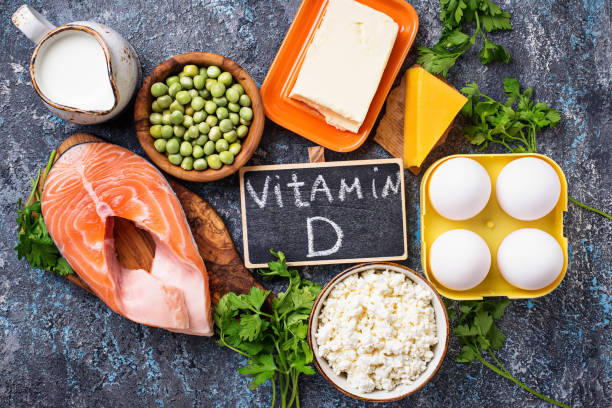Vitamin D

Overview:
Vitamin D belongs to sterol family having functions resembling to hormones. Usually it has two active forms, Ergocalciferol and Cholecalciferol known as vitamin D2 and D3 respectively. These are functionally active forms of vitamin D produced from dormant pro vitamin form.
Conversion of pro vitamins to active form occurs in the presence of sunlight (ultraviolet light) or other light sources. Vitamin D belongs to the class of fat soluble vitamins. It increases absorption of magnesium, phosphate and calcium along with other physiological functions. Naturally, it is not found in so many foods.

Sources:
Vitamin D is present in a few natural sources. Intake of vitamin D is necessary for bone strength. Following are some of the most important sources of vitamin D:
- Salmon
- Vegetables
- Egg yolks
- Sword fish
- Sardines
- Tuna fish
- Fortified food
- Beef liver
- Dairy products
- Vitamin D fortified orange juice
- Mushrooms
- Cereals
- Cod liver oil
- Cheese
- Ultraviolet rays
Functions:
Vitamin D is essential for normal health of the body. Following are some important functions performed by Vitamin D:
- Bones: Vitamin D is responsible for much of the strength of bones. They regulates absorption of calcium from intestine and thus promote bone growth. It plays following roles:
- Reduce fracture risk
- Body balance
- Remodeling of bones
- Strengthen skeletal structure of body
- Maintain bone density
- Mobilizes calcium
- Promote calcium reabsorption from distal part of kidney
- Intestine: Active form of vitamin D optimized calcium absorption of calcium from intestine. It may be taken via mouth or may be produced by skin exposed to sunlight.
- Muscles: Vitamin D is also important for muscle strength. Metabolism of vitamin D produces a metabolite which is essential for working of muscles (i.e contraction and relaxation).
- Dental health: Vitamin D also plays its part in health of teeth. It also protect from decaying teeth. It maintains gum strength and avoids all types of dental infection.
- Kidney: Vitamin is also responsible for healthy kidneys. It protects the renal functions and also reduces any risk of contamination.
- Wound and injuries: Vitamin D is also involved in pathways of healing. It promotes metabolism, growth and repair of cells.

Deficiency:
Deficiency of vitamin is characterized by a condition known as hypovitaminosis. In this condition vitamin D level of body is below normal.
Causes:
Different factors are responsible for deficiency of vitamin D. These factors may be pathological or physiological:
- Intestinal diseases: In these diseases, normal amount of vitamin D is not absorbed from the intestines. Examples of these diseases include:
- Crohn’s disease
- Celiac disease
- Cystic fibrosis
- Surgical weight loss: In some conditions surgeries are performed for weight loss. In such surgeries, stomach size and length of intestine is lessened which makes it hard to absorb and utilize enough quantity of minerals and nutrients. In such individuals, proper monitoring and use of supplements is necessary for survival.
Symptoms:
Signs and symptoms of deficiency of vitamin D are not quite obvious but underlying cause following conditions may suggest vitamin D deficiency:
- Joint deformation
- Muscle weakness
- Abnormal growth pattern
- Depression
- Muscle cramps
- Fatigue

Toxicity:
High level of vitamin D can lead to vitamin D toxicity. This toxicity is often seen in case when a person is using vitamin D supplements.
Human skin has limited capacity to form vitamin D so increased exposure to sunlight do not cause toxicity.
High level of vitamin D leads to increased calcium level in body predisposing to many disease and medical anomalies.
Symptoms: Hyperthyroidism may lead to increased vitamin D level. Following signs and symptoms are associated with hypervitaminosis D:
- Failure to thrive
- Nausea
- High blood pressure
- Loss of appetite
- Kidneys fail to function properly
Management: Following measures should be taken to minimize vitamin D related toxicity:
- Oral Aluminum hydroxide is used in case of children.
- Stop using vitamin D supplements.
- Oral sodium versenate is used.
- Reduce calcium intake.






